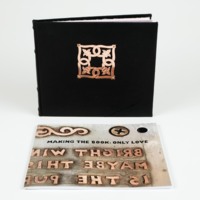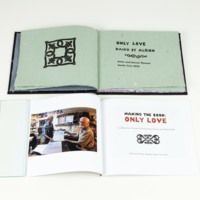A158. Only Love: A Haiku
A158. Albion Smith. Only Love: Haiku by Albion. Santa Cruz, California: Peter & Donna Thomas, 2016.
19 x 22 x 3 cm (7 5/8” x 8 ½” x 1 3/8”) 30 copies.
Binding: Full-bound in black pigskin. Copper pierce-work by Albion Smith inset on cover. End sheets dark blue, hand-made by Albion Smith and Peter and Donna Thomas. Accompanied by Making the Book: Only Love. Both volumes housed in a clamshell box covered in red and black cloth. Paper: Six shades of paper, handmade by Albion Smith and Peter and Donna Thomas from Smith’s work shirts. Printing: Letterpress; printed from aluminum plates made by Albion Smith. Typography: Poems are hand set in hand-cut type, cut from jeweler’s copper by Albion Smith and attached to aluminum plates. Additional text is hand set Spartan Bold. Illustrations: Only Love has ornaments and a print of the copper pierce-work that is inset on cover. Notes: Making the Book: Only Love is perfect bound and printed on commercial paper. The text is digitally set in Spartan Bold and titles are AS_coppercut, the digital version of Albion Smith’s hand cut letters. Making the Book: Only Love includes digitally printed photographs of Albion Smith, his jewelry, his original book, and of the papermaking, printing, and binding required to make the book. AS_coppercut was digitized from Albion Smith’s hand-cut copper letters by Malcolm Raggett.
“The text of the book Only Love is a series of haiku poems written by Albion. The text of Making the Book documents the creation of the book and the work of the artists. The photographs in Making the Book document Smith’s workshop, jewelry, and original book, as well as the papermaking, printing, and binding of the book Only Love.
Donna and I first met Albion in 2014 when he stopped to see our books during Open Studios, a three-weekend event in Santa Cruz, where artists show their studios to the public. Albion admired our work, toured our ‘gypsy wagon’ trailer, and then mentioned that he was also an artist, a jeweler. He also told us that he had lived and worked out of a converted school bus for years and had hand-printed a book of his own poetry. The feeling of kinship was immediate. He invited us to visit and we gladly accepted.
We found Albion no longer lives and works out of the school bus. His jewelry studio is a hand-built wooden structure nestled amidst the gardens of his bucolic mountain home. Albion showed us his book, Only Love, an unassuming four by five-inch paper-covered pamphlet with twenty-eight of his haiku poems. It seemed ordinary until Albion described how he had made it. He had never printed before, and like Johann Gutenberg in the fifteenth century, he had used his jeweler's skills to create his own system for letterpress printing. Where Gutenberg had invented a way to cast multiple units of metal type from an original punch and matrix, Albion used his jeweler’s saw to cut each of the 1,217 individual letters out of sheet copper. The typeface he created is reminiscent of Rudolph Koch’s Neuland types. They share the same aesthetic, each letter being originally cut in metal. Albion had then glued those letters in place on sixteen separate aluminum plates, one for each page of the book. He printed the type plates one at a time, four impressions per page, using a press of his own design and construction - based loosely on the tortilla press in his kitchen. Once printed he folded the four sheets in half, nested them in a thicker piece of cover paper, then stitched them together through the spine. The finished book was both a labor of love and a significant accomplishment.
When Albion took us to see his jewelry we expected to see necklaces, rings and earrings. Instead we found he made elaborate jewel-encrusted goblets and ornately detailed gold and silver teapots. We stood in awe. In a moment of audacious artistic impulse, we asked permission to use his original type plates to make an editioned book. The aesthetic allure was there: Albion’s haiku had a raw, simple beauty that was natural and unforced, a quality the hand-cut letterforms embraced and enhanced. It would make a stunning, simple, and elegant fine press book when printed on handmade paper and bound in leather. We did not want to create any undue expectations for Albion so explained that printing an unknown poet’s work in a lavish edition generally did not lead to financial gain. We were answering the call of our muse, and would do it for the sake of creating art. As both artist and craftsman, and disregarding practicality, Albion embraced the project. He offered to help make the paper and print the book, asking if we could use his old work shirts for the paper pulp, and agreeing to cut a copper pierce-work embellishment for the cover of each book. So the project began.
While working together we found time to discuss our art practices and our aesthetics. We found much in common. The jeweler and fine press printer both work with the finest materials they can afford, striving to produce the most beautiful object their skills can realize, attempting to achieve perfection. Haiku poetry and fine press printing both find strength in simplicity and the refinement of minor details. In both practices, the search for the right word, or the decision that brings a sense of aesthetic completion to the work, often takes as much thought and effort as all the proceeding work combined. Together we made the paper, printed the text, sewed and then bound the first trial copy. We could see the binding was done but the project was not complete. For our reader to fully appreciate what they were holding, we needed to create a companion volume. It would have photographs showing Albion’s jewelry and his own edition of the book, and would document our collaboration while making Only Love. But, we realized, for that companion book to be done right we would need to digitize Albion’s copper-cut letters so that the typeface could be used in it. Then, reaching a point of satisfaction with the project and knowing we could continue making improvements forever, Albion, Donna, and I agreed to call the project complete. Even so, that may not be the end: the existence of the digital face beckons further collaboration.”

